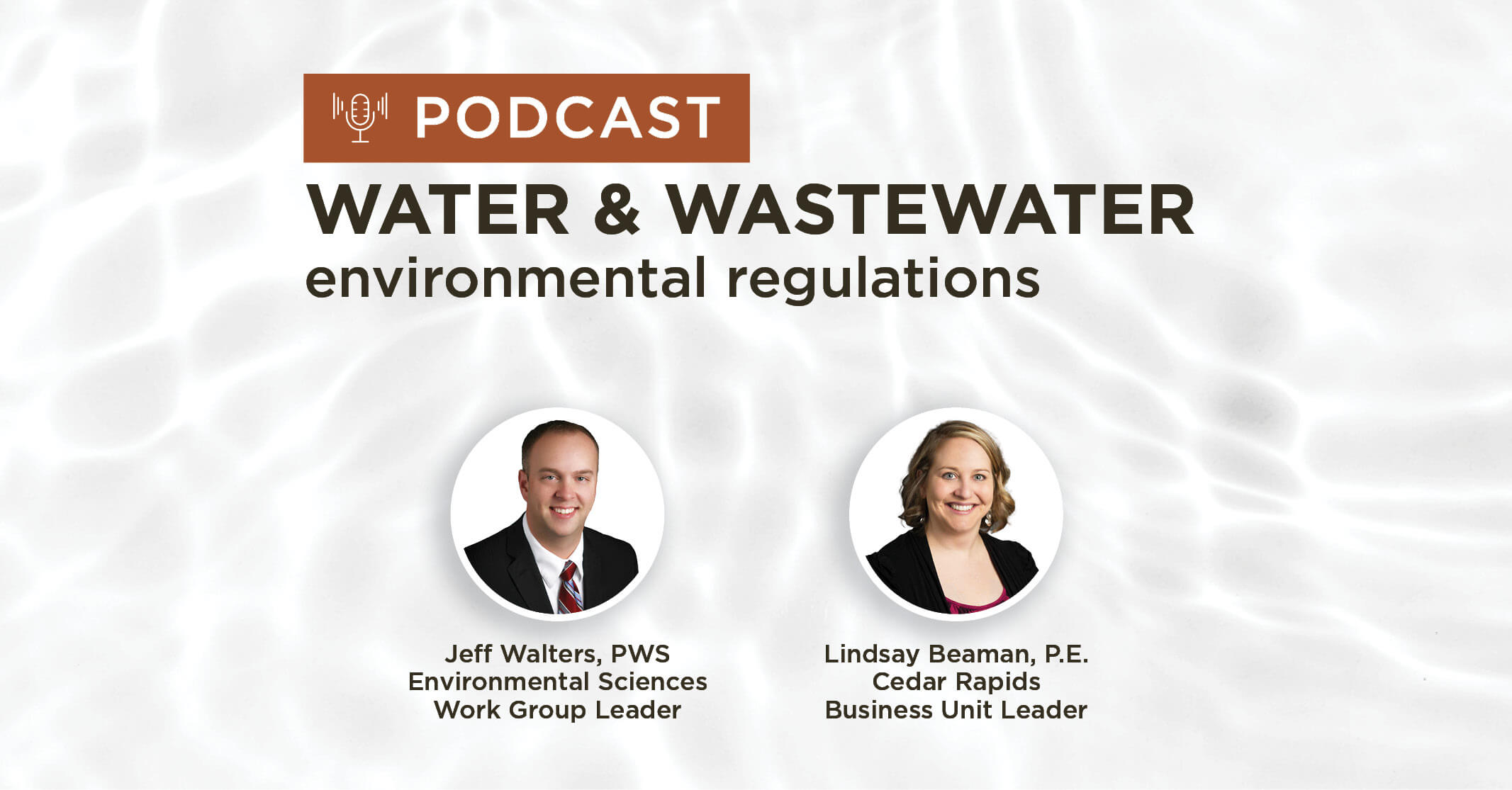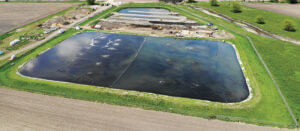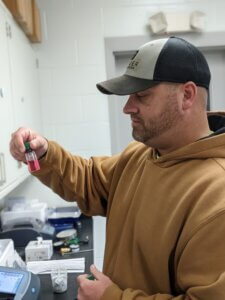Wastewater Treatment Challenges and Solutions
Before the 21st century, wastewater was disposed of in lakes and rivers due to the lack of knowledge and technology that is now so adamantly apart of our lives today. The advancements that continue to progress improve wastewater regulatory compliance, although, it is not without challenges. Municipalities face many challenges with their wastewater facilities. Water quality fluctuates due to environmental changes, requiring constant updates to new water quality standards.
Water quality is an essential part of a healthily functioning community. Listen in to find out details on how our experts can put their experience to work for your benefit. Environmental scientist, Jeff Walters, PWS, and wastewater engineer Lindsay Beaman, P.E. discuss the stringent, evolving water quality standards, the challenges that come with them, and the success associated with proactive project planning.
Podcast Agenda
- Meeting NPDES Permit Requirements (1:44)
- Varieties of Waste Materials (2:19)
- Common Environmental Hurdles (4:18)
- Snyder & Associates Assistance Options (5:55)
- Industry Trends (8:28)

Jeff Walters, PWS
Environmental Sciences Work Group LeaderJeff Walters, PWS
Environmental Sciences Work Group LeaderWetland & Stream Delineation & Mitigation, 404 Permitting, Natural Resources Surveys, Lake & Stream Restoration

Lindsay Beaman, P.E.
Cedar Rapids Business Unit LeaderLindsay Beaman, P.E.
Cedar Rapids Business Unit LeaderWater System Analysis & Planning, Design & Construction, Wastewater Treatment Design, Municipal Engineering
Complying with Evolving Water Quality Standards
Jeff Walters (0:18)
Lindsay, let’s start with these four questions. What is your biggest industry or sector issue pertaining to environmental regulations right now?
Lindsay Beaman (0:30)
Within the water and wastewater sector, I would say the biggest issue that we have is the changing water quality standards as it relates to what goes into our existing bodies of water or receiving streams and how we’re able to fund that and meet those requirements in this changing environment.
Jeff Walters (0:46)
And that’s been an issue for really decades since the clean water act started is how do wastewater facilities or those types of facilities that have wastewater discharge permits get rid of their waste. Because pre-clean
water act, you could do whatever you want with it. You could dump it in the river, dump in the Lake and it’s no big deal. But as we have moved into the 21st century and we’ve got a lot of technology these days, the constituents that go into the water through our waste streams are just getting tighter and tighter. So yeah, it’s definitely been around for a while and it’s never going away as long as the clean water act is still involved.
Lindsay Beaman (1:24)
Yeah. And I think as we further educate ourselves as to what our impacts are, what we can do better, what technologies are available to us, we can continue to improve upon that. So even though the clean water act hasn’t changed a whole lot over the decades as consumers and users and environmental stewards, we figured out ways to do better and to change the rules to help ourselves.
Meeting NPDES Permit Requirements
Jeff Walters (1:44)
As we dissect the clean water act and especially the NPDES permits related to the wastewater facilities, have you noticed any particular constituents that are getting tougher for your clients?
Lindsay Beaman (1:56)
The ammonia and the dissolved oxygen as well as disinfection, are the things that are a challenge. But on the water treatment side as well, it’s the byproducts of water treatment that in the past we didn’t think much of what we were putting back in the rivers and streams from drinking water. But now that’s become something that we’re watching, especially in smaller streams. The impacts that those have on the receiving streams.
Coal Combustion Residue (CCR)
Jeff Walters (2:19)
I know back in the day when I was working with MidAmerican Energy Company and some other clients that had a coal combustion residue (CCR) or other types of material, the EPA and DNR just didn’t know what to do with them. So there became these massive stockpiles of waste byproducts that weren’t quite solid and it wasn’t quite a liquid. And we estimated it could take years or even decades to dry out this material. Have you seen those types of issues at your wastewater facility treatment plants?
Lindsay Beaman (2:54)
Nothing that we’re focusing on at this point. There are always the deeper discussions, now we’re gonna get really deep into water quality here, is with the pharmaceuticals or other micro products within the waste stream that we’re putting into our receiving streams that right now we don’t quantify them well. We don’t know what to do about them or how to treat them. But it’s one of those topics where you think, Hey, 50 years from now we’ll be looking back and saying, can you believe we used to dump those into the rivers? Because I’m guessing that we’ll have that conversation later, that what we’re doing today is crazy to us tomorrow.
Pharmaceuticals
Jeff Walters (3:26)
Do you think it’s maybe just a component of technology today that we’re just having a difficult time quantifying the constituents from like say pharmaceuticals when people are dumping them down the drains and flushing the toilet?
Lindsay Beaman (3:41)
Yeah. It’s the technology to do something about it and the interest in tracking it because ultimately it comes down to if we can barely fund what we have now for our current needs, it’s hard to create new legislation that’s going to be more impactful when we don’t have a good idea of what that is costing us on the other end. So I think that there’s a lot of hesitation to do much more with environmental regulations and as we can continue to pick off what we have already undertaken as a society that we need to correct. So I think that’s also part of the discussion.
Common Environmental Hurdles
Jeff Walters (4:17)
So what are some common environmental hurdles you and your clients are currently working through?
Lindsay Beaman (4:23)
In addition to meeting permit limitations for new compliance, new regulations, maybe different facilities need to get up to speed. When you think about it, especially when it comes to sewage conveyance and wastewater treatment, a lot of that process, it’s always going to be located in low-lying areas near rivers and streams, especially near rivers. And so we deal with a lot of hurdles in construction in conveying, in being able to excavate without polluting the receiving streams, and being able to keep our rivers protected without flooding our sites. Because obviously, a flooded treatment plant isn’t going to do anybody any good. So there are a lot of hurdles in the location and the needs of expanding these facilities.
A lot of those decisions you talk about, there are so intermingled in the discussion of should we build this here and how this will be impacted by flooding. We have to go down certain roads of making these determinations way farther than we would normally do. And we might find out that you’re hitting dead ends. And so, you almost have to go down the road in the wrong direction several times before you can find out the best way to make a decision. Because sometimes clients will ask, well, why didn’t you think to do that? And it wasn’t that we didn’t go down that path. We found out we’re hitting a major obstacle and permitting that isn’t beneficial anymore. And so it’s amazing how often you have to go down these routes to find out what’s the best big picture solution.
Snyder & Associates Assistance Options
Jeff Walters (5:55)
How does or how can our Environmental Business Unit at Snyder support your clients in these types of projects?
Lindsay Beaman (6:02)
Well the permitting, obviously is a big assistance and helping to provide that baseline guidance when a project is starting up. When you can foresee challenges that might not be overcome based on previous experience, for starters. Experience on any project is so valuable because you look at the big picture and say don’t go that direction. You’re going to waste your time and money. Wetland mitigation is a huge impact, stream mitigation, when we have to do some of these projects and we know that we’re going to have disturbances helping to eyesight that ahead of time, what is going to be the least impactful or the most beneficial to a client? And having that broad experience in a team that helps us to educate them because it’s one thing for me to say, Hey, my Environmental Business Unit team says, don’t do that. But it’s another thing to have your experience when you sit down and help explain that to our clients. That’s been very helpful.
Jeff Walters (6:53)
Yeah, the one thing that I find is probably the most successful is when the Environmental Business Unit can get involved early in that project. Especially when you’ve got these long lead projects, you know you’ve got a deadline you have to meet and while a year or two or five years may seem like a long time, once we start doing the environmental documentation with boots on the ground doing fieldwork, shovel tasks and identifying streams and wetlands, we inadvertently add that layer of complexity to your project and that level of complexity also adds a high cost potentially to your client as well. So it’s important for us to get in there early, understand what’s going on so that you don’t get too far down that design path and then have to redo it.
Lindsay Beaman (7:53)
Exactly. Yeah. We talk about, very often, that five years is a very typical project length for water and wastewater treatment type projects, especially when it comes to meeting a compliance schedule. And clients think that that’s all the time in the world, but in reality, I know that you need every second of that and if you’re ever going to make it on time. So yeah, they realize how many different layers there are and how important it is to have a really good foundation started early with an environmentally conscious thought process as well as funding and all the different layers that any engineering has involved.
Industry Trends
Jeff Walters (8:28)
What are some of the foreseeable changes you anticipate within your client portfolio in the industry?
Lindsay Beaman (8:35)
I think that we’re going to see a continued trend of more and more environmental needs, hurdles, awareness where we need to comply to take care of our future Earth and the needs of our future generations. I know that we haven’t really even touched on nutrients within the state of Iowa, but that’s something that is becoming more and more of a conversation. What are we going to do with the nutrients that we’re sending to the streams from not only wastewater plants but non-point sources? Where can we do something to better our environment? And that might be coming from wetland projects, that might be coming from more treatments compliance projects. That might be something that we have yet to discover. So I think that we’re going to uncover more needs that we don’t know of now. We’re going to have longer lead times on the things that we are doing and we’re going to need a lot more experts within the environmental realm to help us guide us through all of those needs.
Maybe not in Iowa we’re not as reliant on river water for source water, but there are many communities that do rely on river water for source water, and we need to protect ourselves from what we’re putting into the environment because we’re ultimately getting that back from the environment. Maybe not directly in our backyards, but somebody else in our communities or country is impacted by whatever we’re putting out into the environment. So we’re going to become more aware of that as well.
Jeff Walters (9:57)
I think we have an opportunity here at Snyder to work with our clients to reduce our waste streams, reduce our waste loads, and hopefully make a better product for the client. Because that’s really our ultimate goal is to see the success of our client.
Well, thank you, Lindsay. I appreciate your time today, and I hope that we can continue these conversations in greater depth. Maybe we can talk about some specific projects down the road and maybe even get the chance to have some of our clients talk, the two of us, and see if we can continue on these conversations and have a better understanding of what our clients really need.


